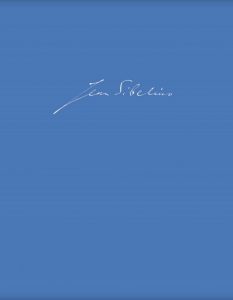Jean Sibelius Works
SON 636: Series I (Orchestral Works) Vol. 13, edited by Timo Virtanen
Pohjola’s Daughter, Op. 49
The Dryad, Op. 45 No. 1
Musik zu einer Szene
Dance Intermezzo, Op. 45 No. 2 (also early version: Tanz-Intermezzo Nr. 1)
Pan and Echo, Op. 53a
The major work in this release of orchestral music from the middle part of Sibelius’s career (c. 1904–10) in the critical JSW Edition is Pohjola’s Daughter, the big Kalevala-themed tone poem premiered in St Petersburg in December 1906 and based to some extent on an unfinished oratorio, Marjatta. The music was also associated for a while with the Luonnotar story in the Kalevala, although the music has nothing to do with Sibelius’s later orchestral song with that name. The editor of the present volume, Timo Virtanen, has written and lectured extensively about Pohjola’s Daughter and his introductory essay expertly guides the reader through the work’s history from its earliest surviving sketches to its reception by Russian and Finnish reviewers. The critical commentary for this work includes fascinating interpretative insights given by Sibelius to conductors Armas Järnefelt and Simon Pergament-Parmet. The latter questioned a verbal indication by Sibelius that the tempo at letter H in the score, if Pergament-Parmet understood the composer correctly, should be ‘a very broad Andante, which in relation to the preceding comes across as an entirely new tempo’. No new tempo is marked, although in the first recording of the work Robert Kajanus slows down suddenly and appreciably at this point (7’21).
An extended manuscript for the abandoned Luonnotar tone poem is included as a facsimile. This fragment (which has been recorded by the Lahti Symphony Orchestra under Osmo Vänskä) is clearly recognizable as the prototype of Pohjola’s Daughter, although it also incorporates musical material later used in the slow movement of the Third Symphony and in the Love Song from Scènes historiques II.
One other work in this volume, The Dryad, is often numbered among Sibelius’s tone poems, although Sibelius called it just a Tonstück (tone piece) and referred to it in his diary as a ‘dance intermezzo’. It is later than its opus number (Op. 45 No. 1) suggests, and was completed in February 1910. Timo Virtanen’s introduction tentatively links the piece with a project (1909) for the Canadian dancer Maud Allan: Allan did in fact use the music as the basis of a dance performance in London in 1911. For such a short piece (around 6 minutes in performance) it is astonishingly varied, ranging from aphoristic music from the world of the Fourth Symphony to lively dance-like passages. A draft version of the final bars, with some differences in the scoring of the motifs, is included as a facsimile.
Musik zu einer Szene, first performed with dancers at a charity concert in 1904, is here published for the first time. The dance scene was named ‘Ein Fichtenbaum – – – träumt von einer Palme (Heine)’ (‘A fir tree – dreams of a palm’), and the piece consists of a dramatic introduction (Andante di molto), a transitional passage (Allegretto) and an infectious dance (continuing in Allegretto); much of the piece is repeated. The autograph score is lost, and the JSW edition makes the assumption that the surviving sources – the orchestral parts and a later copy of the score by Toni Kanzler – place the beginning of the repeat incorrectly in bar 25 (taking in most of the transition), and changes it to bar 72 (the dance). Musically this does undeniably make sense although one might have expected the orchestral parts to have shown handwritten evidence of such a correction. The Dance Intermezzo is a substantially revised version of Musik zu einer Szene, initially for piano with the orchestral score following afterwards (published in 1907). Four curtain-raising bars from the harp replace Musik zu einer Szene’s introductory section and there are numerous changes later on, including a more emphatic ending (and no repeat). As an appendix the volume includes a formerly unpublished, slightly more heavily scored version of the piece (c. 1906–07), ‘Tanz-Intermezzo Nr. 1’.
Pan and Echo dates from 1906 and was also first performed at a charity concert, with dancers. Although Sibelius himself conducted that performance, he seems to have attached little significance to the piece later on – which is a pity, as it is perfectly well crafted from start to finish, from the pastoral calm of its slow introduction to the intensity of its thrilling final stretto. It bears the opus number 53a, although there is no Op. 53b. Here it is suggested that Sibelius had planned to add Cortège (JS 54; composed for the retirement of Kaarlo and Emilie Bergbom from the National Theatre in 1905) as Op. 53b, although in the end that work remained unpublished).
This is a very valuable release, combining one acclaimed masterpiece and a number of appealing shorter works. The latest scholarship provides in-depth, reliable information and production values, as always with this series, are first rate.
Text: Andrew Barnett and Ian Maxwell
Review copy kindly supplied by Breitkopf & Härtel
Breitkopf & Härtel. Price: €233.00 – 244 pages – ISMN: 979-0-004-80391-2
Click here for link to Breitkopf & Härtel’s website and to order this volume.
The website of the Jean Sibelius Works project has been renewed. The new version of the site can be accessed here: Jean Sibelius Works
